Flag of Vietnam
 |
|
| Name | Cờ đỏ sao vàng ("Red flag with yellow star") |
|---|---|
| Use | Civil and state flag and ensign |
| Proportion | 2:3 |
| Adopted | September 5, 1945 (as flag of DRV) July 2, 1976 (as flag of the Socialist Republic of Vietnam) |
| Design | A large yellow star right in the middle of a red flag. |
 |
|
| Variant flag of Vietnam | |
| Use | War flag and naval ensign |
| Proportion | 2:3 |
| Design | As above, with a yellow slogan "Quyết thắng" (Determined to win) added to left upper corner. |
The flag of Vietnam from 1976, officially the Socialist Republic of Vietnam, also known as the "red flag with yellow star" (cờ đỏ sao vàng), was designed in 1940 and used that year during an uprising against French rule in Cochinchina. The flag was used by the Việt Minh, a communist-led organization created in 1941 to oppose Japanese occupation. When the Japanese surrendered at the end of World War II, Việt Minh leader Hồ Chí Minh proclaimed the Democratic Republic of Vietnam in Hanoi with himself as president. Hồ signed a decree on September 5, 1945 adopting the Việt Minh flag as the flag of the DRV. The DRV became the government of North Vietnam in 1954 following the Geneva Accords. The flag was modified in 1955 to make the edges of the star sharper. The red background was inspired by the flag of the communist party, which in turn honors the red flag of the Paris Commune of 1871. It symbolizes revolution and blood. The five-pointed yellow star represents the unity of workers, peasants, intellectuals, traders and soldiers in building socialism. Until Saigon was captured in 1975, South Vietnam used a yellow flag with three red stripes. The red flag of North Vietnam became the flag of a united Vietnam when the Socialist Republic of Vietnam was formed on July 2, 1976.
Contents |
Design
The flag has a red background with a five-pointed yellow star in the center. It was first used in the "Southern Uprising" (Nam Kỳ Khởi nghĩa) of November 1940 against French rule in Cochinchina.[1] Writer Sơn Tùng, whose research was published in the official press in 1981,[2] found that the flag was designed by Nguyễn Hữu Tiến, a leader of the uprising who was born in the northern village of Lũng Xuyên.[1] Hồ is said to have reproduced the flag based on sketchy radio reports of the uprising.[1] Tiến, who was arrested and executed by the French in advance of the failed uprising, was unknown to the Vietnamese public before Tùng's research was published.[1] The red background represents blood while the yellow foreground represents "the color of our mom's skin," according to a poem Tiến wrote.[1] The five points of the star represent intellectuals, peasants, workers, traders and soldiers.[1] Tiến's poem reads in part:
-
- ... All those of red blood and yellow skin
- Together we fight under the nation’s sacred flag
- The flag is soaked with our crimson blood, shed for the nation
- The yellow star is the colour of our mother's skin
- Stand up, quickly! The nation’s soul is calling for us
- Intellectuals, peasants, workers, traders and armymen
- United as a five-pointed yellow star...[1]

In April 2001, Vietnam's Ministry of Culture reported that there was no documentation to support the claim that Tiến designed the flag.[3] In 2005, Lê Minh Đức, an official of Tiền Giang province, suggested that that the flag was designed by another cadre, Lê Quang Sô, a native of Mỹ Tho Province in the Mekong delta.[3] Đức's theory is based on statements by Sô's son as well as Sô's 1968 memoir.[3] According to Đức, yellow was chosen to represent Vietnam while the red background was inspired by the flag of the Communist Party and represents revolution.[3] Such red backgrounds are characteristic of the flags of Communist nations and honor the Red Flag flown by the Paris Commune of 1871.[4] Sô experimented with stars in various positions and sizes before choosing a large star in the center for aesthetic reasons.[3] This placement may have been influenced by the flag of the Việt Quốc, a nationalist party allied with the communists at that time. In April 1940, the flag was approved by Phan Văn Khỏe, the Communist party chief of Mỹ Tho.[3] It was approved by the national party in July.[3] The official press has not commented on Đức's version of events, but has published material reiterating the view that Tiến designed the flag.[1]
The flag was displayed a conference on May 19, 1941 at which the Việt Minh was founded. The Việt Minh proclaimed its flag a "national flag" on August 18, 1945 at a meeting held in the village of Tân Trào in the North. When the Japanese surrendered at the end of World War II, the Việt Minh entered Hanoi and proclaimed the Democratic Republic of Vietnam on September 2. On September 5, DRV President Hồ signed a decree adopting the Vietminh flag. French troops returned in October and restored colonial rule. Following the Geneva Accord between Việt Minh and France in 1954, the DRV became the government of North Vietnam. In November 1955, the flag's design was modified slightly to make the star smaller and its edges straighter. This followed a similar modification of the Flag of the Soviet Union. The flag was adopted in the South in 1975 after the North Vietnamese army overran Saigon, the South Vietnamese capital. North and South were unified as the Socialist Republic of Vietnam on July 2, 1976.
Historical flags
The Trưng sisters flew a yellow banner during their revolt against China in AD 40, as did Triệu Thị Trinh in 222-248.[5] A yellow banner with a red circle in the center was adopted as a standard by Emperor Gia Long (1802-1820).[6] This standard was used by supporters of the anti-French Cần Vương, or "Save the king", movement in 1885, effectively making it Vietnam's first national flag.[6] Emperor Thành Thái's flag, adopted in 1890, had red stripes and a yellow background.[5] The three stripes represented the Quẻ Càn, or Qian trigram, one of eight trigrams used in the I-Ching, a Taoist scripture.[5] (Compare to the Flag of South Korea.) Quẻ Càn is the divination sign for heaven.[5] Later, the stripes were said to represent the northern, central and southern regions of Vietnam.[5]
The French, who gradually gained control of Vietnam in the late 19th century, flew the Tricolour, the French national flag. As the colony of Cochinchina (1864-1945), the South was under exclusive French authority. In contrast, North and Central Vietnam were protectorates with parallel systems of Vietnamese and French administration. Several flags were flown in these regions: the French flag, the Vietnamese imperial flag, and a "protectorate flag." From 1920 to 1945, the Vietnamese imperial flag had a yellow background with a single, broad red stripe.
Japan occupied Vietnam in 1941-45. In March 1945, the Japanese deposed the French colonial authorities and proclaimed an Empire of Vietnam with Bảo Đại as emperor. The Quẻ Ly Flag, also a red trigram on a yellow background, was adopted in June. Among other things, Quẻ Ly symbolizes the direction south. Bảo Đại abdicated in August when Japan surrendered. The French returned in October 1945, but were challenged by the Vietminh, especially in the North. The French proclaimed Cochinchina a republic in June 1946. This puppet state adopted a Quẻ Càn flag with blue stripes on a yellow background.
In May 1948, the name of the Cochinchina government was changed to "Provisional Central Government of Vietnam" in preparation for a merger with the North as outlined in the Hạ Long Bay agreements between France and Bảo Đại. On 2 June 1948, Chief of State Nguyễn Văn Xuân, signed an ordinance to adopt a redesigned Quẻ Càn flag: "The national emblem is a flag of yellow background, the height of which is equal to two-thirds of its width. In the middle of the flag and along its entire width, there are three horizontal red bands. Each band has a height equal to one-fifteenth of the width. These three red bands are separated from one another by a space of the band's height." This flag was used in the South under the subsequent State of Vietnam (1949-55) and the Republic of Vietnam (1955-75).
| Flag | Duration | Use | Name/Description |
|---|---|---|---|
 |
1802-1885 | Flag of Nguyễn Dynasty | Long tinh (Dragon Spirit) flag |
.gif) |
1885-1890 | Đại Nam Kỳ (National Flag of the Great South) | |
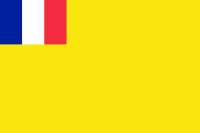 |
1887 – 1953 | Flag of French Indochina | French flag canton on a yellow field |
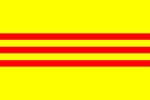 |
1890 – 1920 | Flag of Nguyễn Dynasty (Emperor Thành Thái) | A yellow field, with three red stripes. The stripes represent the Quẻ Càn, or Qian trigram, also interpreted as representing the regions of Vietnam (North, Central, and South). |
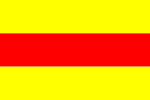 |
1920 – 1945 | Flag of Nguyễn Dynasty and Annam (French protectorate) | A yellow field, with single red stripe (Long tinh (Dragon Spirit) flag). |
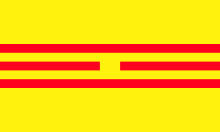 |
March – August 1945 | Flag of the Empire of Vietnam during Japanese occupation | A yellow field, with three red stripes. The stripes represent the Quẻ Ly, or Li trigram. |
 |
1946 – 1948 | Flag of the Autonomous Republic of Cochinchina (Nam Kỳ Cộng hòa quốc) | Cochinchina is a precursor of South Vietnam |
 |
1948 – 1975 | Flag of the State of Vietnam (1946-1954) and of South Vietnam (1954-1974) | A yellow field, with three red stripes. (Identical to Thành Thái's flag.) |
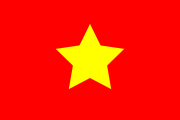 |
1945 – 1955 | Flag of North Vietnam | A red field, with a large yellow star. |
 |
1955 – present | Flag of North Vietnam (1955-76) and the Socialist Republic of Vietnam (1976 - present) | A red field, with a large yellow star. |
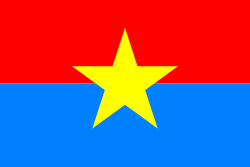 |
1960 – 1975 | Flag of the Vietcong, or Provisional Revolutionary Government of the Republic of South Vietnam | A yellow star, with red and blue background. |
Vietnamese Heritage and Freedom Flag
In the United States, from February 2003 to August 2006, 13 States, 7 Counties and 85 Cities have adopted resolutions recognizing the former South Vietnamese flag as the Vietnamese Heritage and Freedom Flag and as the Official Flag of the Vietnamese American.[7][8] The Vietnamese Heritage and Freedom Flag is permanently displayed at memorial sites at Westminster, California and Cabramatta, Australia. The Vietnamese government opposes these efforts and complained to the United States federal government on the grounds that it is a sovereign country with diplomatic relations with the United States. This flag is de facto banned in Vietnam. In contrast, the current Vietnamese flag is considered offensive by many overseas Vietnamese.
See also
- Flag of North Vietnam
- Flag of South Vietnam
References
- ↑ 1.0 1.1 1.2 1.3 1.4 1.5 1.6 1.7 "VN Embassy : Flag Designer Urban Myths Squelched", Embassy of the Socialist Republic in Vietnam in the United States of America.
- ↑ Sơn Tùng's writing was published in installments in the newspaper Sài Gòn Giải Phóng and later as book entitled Nguyễn Hữu Tiến (1981).
- ↑ 3.0 3.1 3.2 3.3 3.4 3.5 3.6 "Nguyễn Hữu Tiến hay Lê Quang Sô?", Tuổi Trẻ, Nov. 23, 2006
- ↑ "Story of the Red Flag", Revolution, 05-19-2006. Retrieved 12-02-2007.
- ↑ 5.0 5.1 5.2 5.3 5.4 "The National Flag of Free Vietnam"
- ↑ 6.0 6.1 Nguyễn Đình Sài, "The National Flag of Viet Nam: Its Origin and Legitimacy"
- ↑ "Resolution Recognizing: The Yellow Flag With Three Red Stripes as The Official Flag of the Vietnamese American"
- ↑ "Michigan, Resolution No. SR148 and HR16"
External links
- Vietnam at Flags of the World
- The National Flag of Viet Nam: Its Origin and Legitimacy or in PDF
|
||||||||||||||
|
||||||||